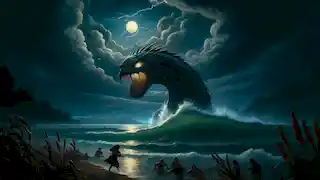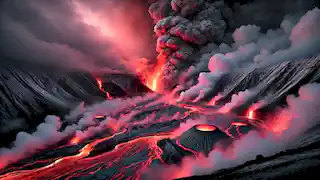Long ago, in the green and mountainous lands of Aotearoa, known today as New Zealand, there existed creatures of immense power and mystery. The Māori people believed in the taniwha, mighty supernatural beings, some said to be guardians, others to be bringers of chaos. These beings lived deep within the waters, guarding sacred rivers, lakes, and harbors, while others carved their homes into the caves beneath the earth, unseen by human eyes. Some were known to protect the iwi, the tribes, guiding them through danger. But not all taniwha were guardians—some were feared for their unpredictable wrath, striking terror into the hearts of those who dared cross their paths. This is the story of one such taniwha, who rose from the depths to protect and destroy, a legend passed down from generation to generation. Te Wairoa, nestled beside the serene waters of Lake Tarawera, was a thriving village where the Māori people lived in harmony with the land and water. The lake, with its deep, dark waters, was a source of life for the people. The villagers fished, gathered food, and bathed in its waters, but they knew not to wander too far. The elders had passed down tales of a taniwha named Kahotea, said to dwell in the depths of the lake. This taniwha was neither a protector nor a friend to the villagers. Kahotea was known for his insatiable hunger, and many who ventured too close to the center of the lake were never seen again. But despite the dangers, life went on as usual for the people of Te Wairoa. The lake had long been calm, with no signs of the taniwha, and some in the village began to doubt the old stories. “Perhaps Kahotea has left us,” they would whisper to one another. “It has been years since anyone has gone missing.” But the village tohunga, the wise priest, knew better. He would often sit at the edge of the lake, watching the waters with a knowing look in his eyes. “Kahotea has not left,” he would warn. “He sleeps, waiting for the right moment. We must never grow too comfortable, for a taniwha’s wrath is unpredictable.” His words were met with respectful nods, but many dismissed the caution as mere superstition. The year was 1886, and the village of Te Wairoa was bustling with the arrival of visitors from across the seas—the Pākehā, European settlers, had begun to venture into the heart of Aotearoa. They were fascinated by the Māori culture, the land’s natural beauty, and most of all, the famed Pink and White Terraces, known as Te Otukapuarangi and Te Tarata, which were said to be the most beautiful natural wonders in the world. These terraces, made of silica, cascaded down the hillside near Lake Rotomahana, not far from Te Wairoa. The Pākehā marveled at the unique formations, and many came to bathe in the thermal pools, believing them to have healing properties. As the Pākehā influence grew, the Māori of Te Wairoa welcomed them, sharing their traditions and land. But with the arrival of these foreign visitors came a new sense of unease. Some in the village believed that the Pākehā’s presence would anger Kahotea. “The taniwha has watched over these lands for generations,” the elders would say. “He will not like the intrusion of outsiders.” Yet, no one could foresee what would come next, and soon the village’s peaceful existence would be shattered. One fateful night, the air grew thick with an unsettling tension. A cold wind blew over the lake, sending ripples across the usually calm waters. The tohunga, sensing something was amiss, gathered the villagers near the shore. “Kahotea stirs,” he whispered, his voice trembling with fear. “We must offer a gift, a sacrifice, to appease him, or we risk his wrath.” But it was too late. A deep rumbling came from beneath the lake, shaking the very earth beneath their feet. The villagers gasped as they saw the water begin to churn violently, waves crashing against the shore with unnatural force. From the depths of the lake, a shadowy figure began to rise. The taniwha had awoken. Kahotea was immense, his scaled body twisting and writhing as he emerged from the water. His eyes, glowing with an otherworldly light, scanned the terrified villagers, and his gaping maw released a deafening roar. The earth shook with his rage, and the once peaceful lake was now a swirling tempest. The villagers screamed in terror, scrambling to escape the shore, but Kahotea was relentless. His massive tail whipped through the air, smashing into the trees and homes that lined the shore. Those who had doubted the taniwha’s existence now realized the true extent of their folly. The tohunga stood firm, raising his staff to the sky. “Kahotea, great taniwha of the lake, hear our plea! We offer you this sacred gift, a token of our respect for your power!” But the taniwha was beyond reason, his hunger and anger too great to be sated by offerings alone. As Kahotea rampaged through the village, destroying everything in his path, the people of Te Wairoa fled in all directions. Some sought refuge in the hills, while others took to the waters in small boats, hoping to escape the taniwha’s fury. As dawn approached, the ground trembled once more, and a sound like thunder echoed across the land. The villagers turned their eyes toward the distant mountains, where a cloud of ash and smoke began to rise. It was Mount Tarawera, the great volcano that had slept for centuries. Now, it too had awoken. The eruption was swift and devastating. A massive explosion ripped through the air, and rivers of molten lava poured down the mountainside, consuming everything in their path. The Pink and White Terraces, once the pride of the land, were buried beneath the ash and rock, lost forever to the fires of the earth. Te Wairoa, too, was not spared. The village, already in ruins from Kahotea’s rampage, was now engulfed in ash and mud. Those who had survived the taniwha’s wrath now faced a new terror—the wrath of the earth itself. But as the fires raged and the smoke filled the sky, something remarkable happened. The waters of Lake Tarawera began to calm. The taniwha, seeing the destruction wrought by the eruption, retreated to the depths of the lake, his fury subsiding. It was as if the eruption had quelled his anger, and Kahotea once more became a guardian of the waters, watching over the lake in silence. In the days that followed the eruption, the survivors of Te Wairoa returned to what was left of their village. The once thriving community was now little more than a wasteland, covered in ash and debris. The Pink and White Terraces, which had drawn visitors from far and wide, were gone, buried beneath the molten earth. Yet, amidst the devastation, the people of Te Wairoa found a sense of peace. Kahotea, though a fearsome creature, had spared them in the end. Some believed that the taniwha had been appeased by the destruction of the terraces, while others thought that the eruption had reminded him of his place in the natural order. The legend of Kahotea lived on in the hearts of the survivors, passed down from generation to generation. The story of the taniwha, who rose from the depths to protect his land, only to be calmed by the wrath of the earth, became a part of the cultural fabric of Aotearoa. To this day, the story of Kahotea and the eruption of Mount Tarawera is told by the Māori people as a reminder of the power of the natural world. The taniwha, though feared, is also respected as a symbol of the balance between the land, the water, and the people who call Aotearoa home. For the Māori, the taniwha represents both the protector and the destroyer, a reminder that all things in nature are connected, and that one must live in harmony with the world around them. The taniwha’s story is not one of good versus evil, but of respect for the forces that shape the land and the lives of those who inhabit it. And so, the tale of Kahotea lives on, a legend that continues to inspire awe and reverence in all who hear it. As the people of Aotearoa continue to honor their ancestors and the land they call home, the taniwha remains a powerful symbol of the enduring connection between the past and the present, the seen and the unseen, and the land and its people.The Village of Te Wairoa
The Arrival of the Pākehā

The Awakening of Kahotea

The Tragedy of the Pink and White Terraces

The Aftermath
The Legacy of the Taniwha

The Story of the Taniwha
Reading Time: 8 min

About Story: The Story of the Taniwha is a Legend Stories from new-zealand set in the 19th Century Stories. This Dramatic Stories tale explores themes of Nature Stories and is suitable for All Ages Stories. It offers Cultural Stories insights. A legend of a taniwha's wrath and the volcanic eruption that reshaped a village's fate.

















